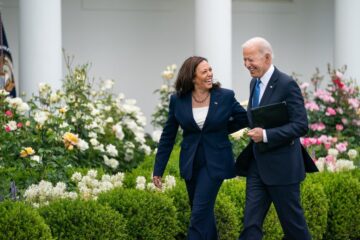Welcome back to Week 48 in my weekly reports analyzing the Covid-19 pandemic and its effects on the country and higher education in the new Biden-Harris administration. For those of you reading this on my blog, Off the Silk Road, I have also launched a newsletter, where these reports can be sent directly to your email each week. Click here to subscribe.
Last week, we shed light on the accelerating vaccine rollout as some states took the foolish step of relaxing restrictions. This week we will focus on President Biden’s new goal for all adults to be eligible for a vaccine by May 1 as we enter into a new phase of the pandemic response.
A national look
This week marked the one-year anniversary since the start of the pandemic in the U.S. After the WHO declared the outbreak a pandemic, the previous administration imposed travel restrictions on Europe a year ago this week and Americans first learned of the terms “social distancing” and “stay-at-home order.” After 532,000 American lives lost, we are finally beginning to see a path toward the end of the pandemic. In his first primetime address on Thursday, President Biden instructed states, tribes and territories to make all adults eligible for the vaccine by May 1. “Let me be clear: That doesn’t mean everyone’s going to have that shot immediately, but it means you’ll be able to get in line beginning May 1,” he said. “Every adult will be eligible to get their shot.” He also put another date on our calendars: July 4. By then, President Biden said that vaccinated people would be able to gather for small events with family and friends. This goal “will make this Independence Day truly special,” he said. It would “not only mark our independence as a nation, but mark our independence from this virus.” Here are the other key elements of this new national strategy:
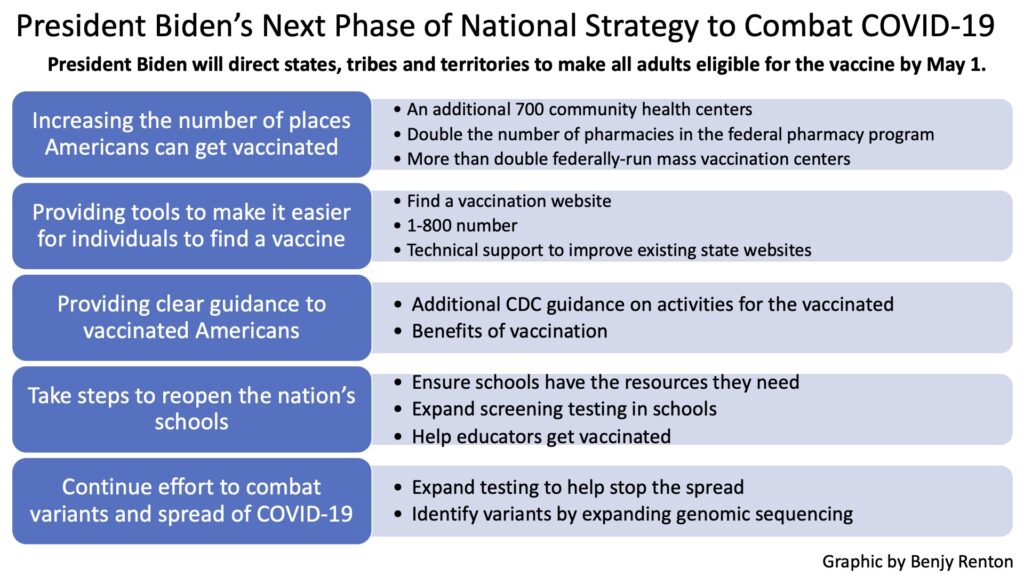
With just weeks to go until mass vaccination, we must still remain vigilant. Although the variants have not caused a huge spike in cases in places such as Florida, where the B.1.1.7 variant currently is estimated to comprise 50% of the cases, there may be some other effects we have not seen yet. However, the vast majority of scenarios include the nation on a downward trajectory in cases, hospitalizations and deaths.
This week was a major week for the Biden administration. The president secured 100 million more doses of the Johnson & Johnson vaccine, the administration will launch a website for all Americans to find vaccination sites near them, and Congress passed the historic $1.9 trillion American Rescue Plan. President Biden also took the first steps to address a global vaccine shortage by partnering with Japan, India and Australia to expand global vaccine manufacturing capacity.
Let’s take a look at some of the latest scientific developments:
- Many people who experience long-term symptoms from the coronavirus did not feel sick at all when they were initially infected, according to a new study that adds compelling information to the increasingly important issue of the lasting health impact of Covid-19. More study is needed with multiple cohorts.
- According to a CDC report, young women of color have been disproportionately affected by Covid-19.
- A preprint on MedRxiv showed that people experiencing homelessness had 30% higher case fatality rates than the general population, suggesting that they should be prioritized for vaccines.
- Hong Kong is currently experiencing an outbreak in the expat community, with over 30 cases linked to a personal trainer in a gym.
- The 28-day risk of death from the B.1.1.7 Covid-19 variant was 64% higher than for previously circulating strains in people older than 30 years, a UK study finds.
- A study published in JAMA of various Orthodox Jewish communities found high levels (as much as 32.5%) of seroprevalence. This surge corresponded to social events surrounding the festival of Purim last March, prior to widespread recognition of epidemic mitigation strategies.
- The CDC and CMS have updated guidance for nursing homes, allowing visits by unvaccinated individuals in most cases.
- In this cross-sectional study of U.S. health care providers in 3 states, community exposures were associated with seropositivity to SARS-CoV-2, but workplace factors, including workplace role, environment, or contact with patients with known Covid-19, were not. These findings provide reassurance that current infection prevention practices in diverse health care settings are effective in preventing transmission of SARS-CoV-2 from patients to health care providers.
- The U.S. death rate increased by 15% last year as a result of the Covid-19 pandemic, the CDC said, making it the deadliest year in recorded U.S. history.
- According to a CDC report, a nonlinear relationship was found between body mass index (BMI) and Covid-19 severity, with lowest risks at BMIs near the threshold between healthy weight and overweight in most instances, then increasing with higher BMI.
- States with Democratic governors had the highest incidence and death rates from Covid-19 in the first months of the coronavirus pandemic, but states with Republican governors surpassed those rates as the crisis dragged on, a study released Tuesday found.
- According to a preprint, the cumulative county-level vaccination rate through March 1, 2021 is significantly associated with a concomitant decline in Covid-19 incidence.
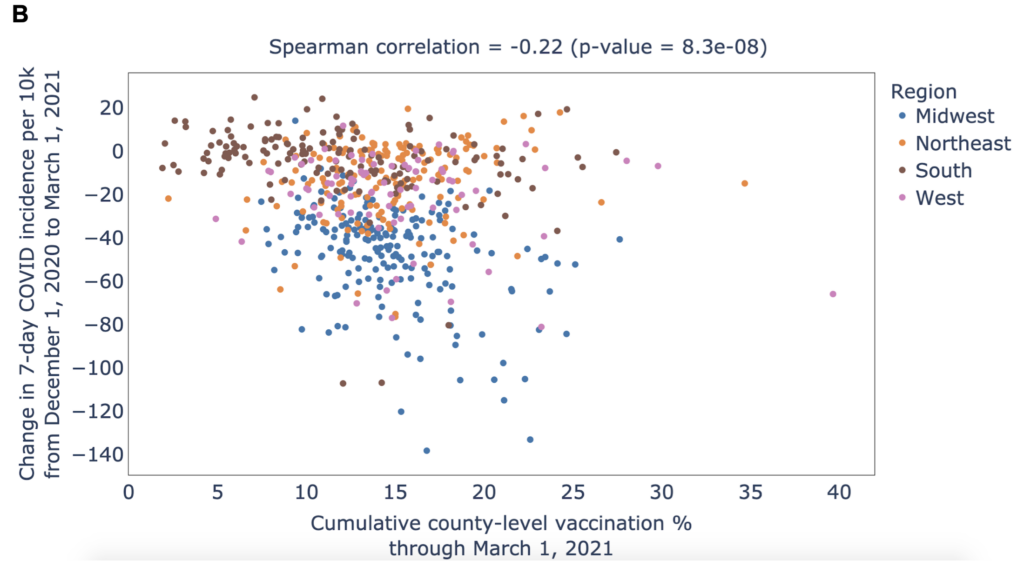
On Saturday, many people were shocked when the CDC reported 4.6 million new doses administered in the past 24 hours, far beyond any previous record. However, the CDC clarified this increase, saying that it pulled data from states later than usual — usually at 6 a.m. If it had pulled the data at the normal time, the day’s reported doses would have been 2.98 million — a record regardless. These data anomalies draw attention to the 7-day average of vaccinations, which is now at 2.5 million per day. Vaccine allocations will be accelerating during these next few weeks as the U.S. just surpassed 100 million shots in arms since rollout began. 1 in 4 adults have received at least 1 dose of the vaccine.
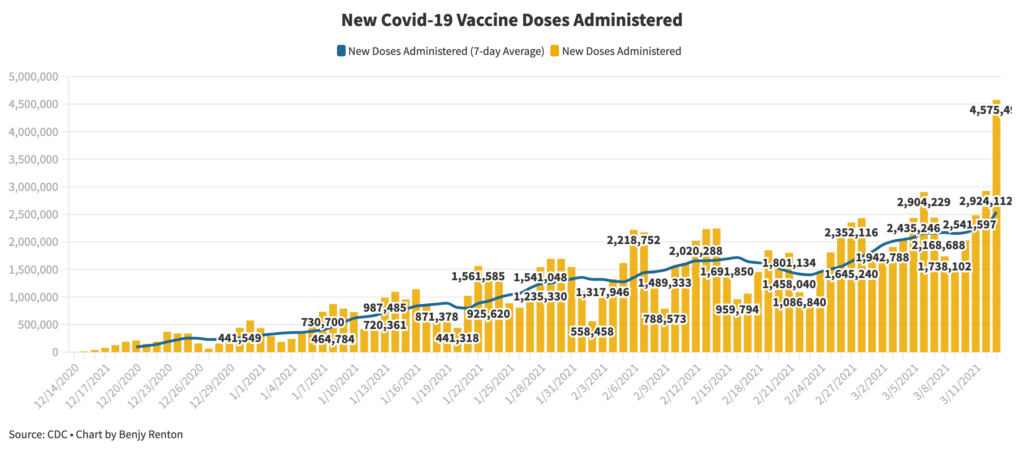
A few other updates on vaccines:
- On Monday, the CDC released its guidance for fully vaccinated individuals (defined as 2 weeks after your final dose). Those who have received their Covid-19 shot can socialize with other fully vaccinated individuals (and low-risk non-vaccinated individuals) indoors without wearing masks or social distancing. They should still wear a mask in public and refrain from travel. Former Baltimore City Health Commissioner Dr. Leana Wen finds these guidelines to be too cautious. “To have our best chance of achieving herd immunity and ending the pandemic once and for all, vaccines should be presented as the ticket back to pre-pandemic life,” she writes. “Time is running out for the CDC and the Biden administration to embrace this approach.”
- This week, public service announcements aired featuring 4 of the 5 living former presidents receiving their Covid-19 vaccines. Each president discussed what he wants to get back to once the pandemic is under control. Notably absent: 45.
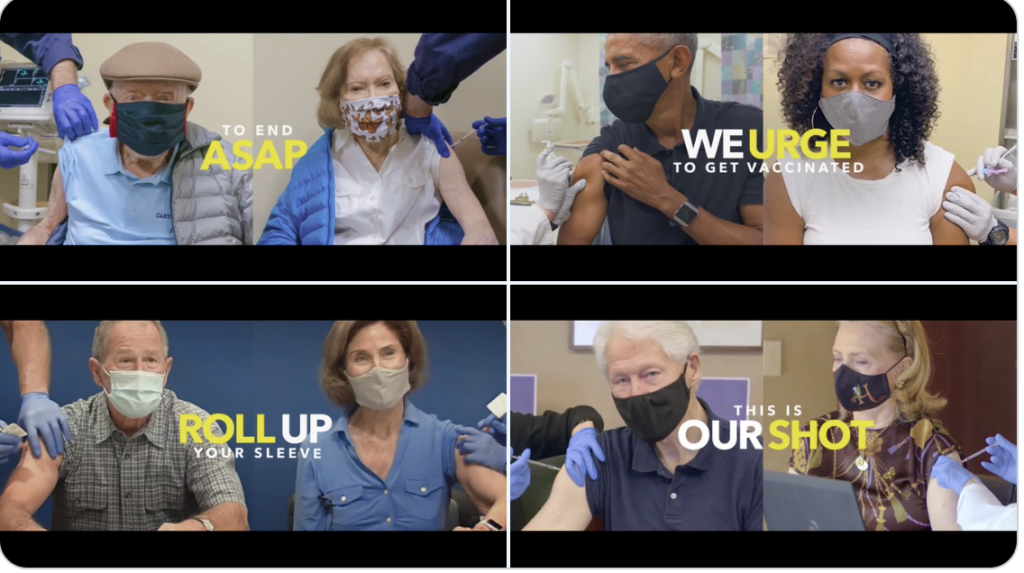
- Alaska has become the first state to remove eligibility requirements for the vaccine. 27% of its total population has received at least one dose, the second-highest in the nation. 17.3% of Alaskans are fully vaccinated, the highest in the nation. In a Twitter thread on Friday, I discussed what we can learn from Alaska and why it is sometimes hard to make an apples-to-apples comparison among states. We must consider each state’s supply, delivery, uptake and population characteristics. As Chelsea Cirruzzo reports in U.S. News & World Report, Alaska has used strategies from previous vaccination campaigns to help reach communities. However, a recent Census Bureau survey shows Alaska having one of the lowest rates of vaccine enthusiasm. The federal government allocates doses to states based on its total population, not the population in each “phase.” For example, 7.5% of Alaska’s population is over the age of 70, compared to 13.4% of Vermont’s population. In the coming weeks, more states will open eligibility to all, but it is difficult to say one state’s strategy is necessarily “better.”
- A study published in The New England Journal of Medicine found that the Pfizer vaccine still elicits a robust immune response against the three major variants.
- Russian intelligence agencies have mounted a campaign to undermine confidence in Pfizer and other Western vaccines, using online publications that in recent months have questioned the vaccines’ development and safety, U.S. officials said.
- In an effort to narrow the vaccination gap by race, BIPOC Vermonters eligible for a vaccine can bring household members to be inoculated, even if they are not otherwise eligible.
- According to an NPR poll, 47% of Trump voters and 41% of Republicans said they will not receive the vaccine. “Vaccine hesitancy” in Black communities is mainly due to access and concerns about the vaccine (which can easily be remedied by answering individuals’ questions) — we need to focus on reaching out to Trump voters.
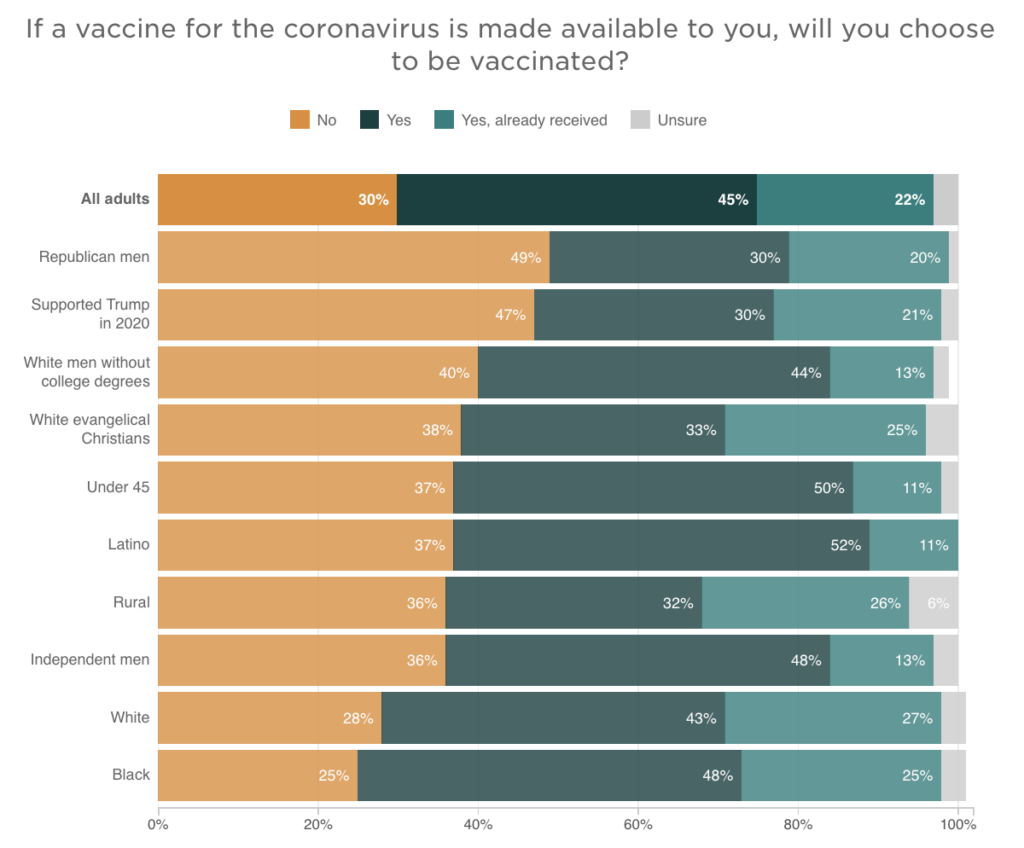
- In a major step for vaccinations in rural areas, the CDC is in talks with Dollar General, which has over 16,000 locations across the U.S. Stores with refrigeration could be used to provide access in rural areas, particularly with the J&J vaccine.
- Kaiser Health News’ Victoria Knight wrote about the concept of vaccination status in dating app profiles.
- California’s new volunteer program allows residents to become eligible for the Covid-19 vaccine by volunteering at vaccination sites across the state
- Novavax announced interim efficacy results from its trials, including 96% efficacy against symptomatic Covid-19, 100% protection against severe disease, 86% efficacy against the B.1.1.7 variant and 55% efficacy against the B.1.351 variant. The vaccine will likely be submitted to the FDA for authorization later this spring.
- According to Pfizer data from Israel, its vaccine was 97% effective against symptomatic Covid-19 and 94% effective against asymptomatic Covid-19.
- In just over a month, CVS and other chains have greatly expanded access to vaccines through the Federal Retail Pharmacy program. Starting with locations in 11 states, CVS is now administering vaccines in nearly 1,200 stores across 29 states.
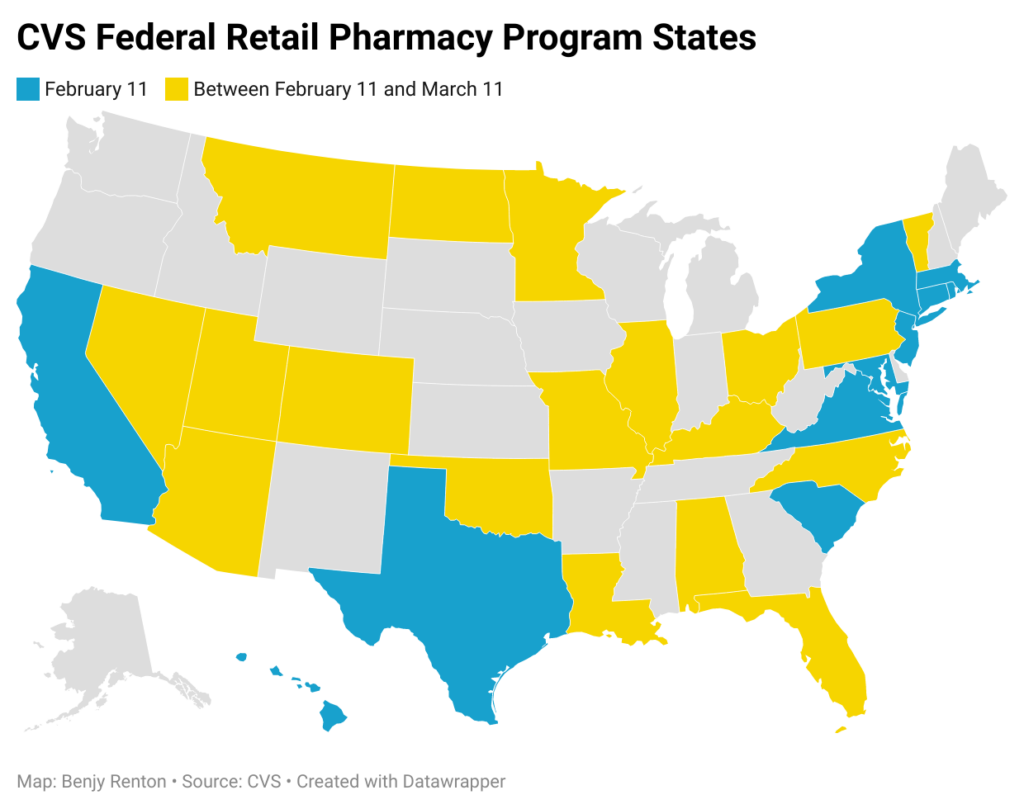
- Mass vaccination sites have been critical in the overall rollout, according to a new commentary in The New England Journal of Medicine.
- Despite low internet coverage, community outreach in Native American communities has worked, leading to high vaccination rates. Many residents highlighted the impact of seeing how much their communities have lost to Covid-19, asserting that was a defining factor in their decision to get vaccinated.
- According to reports from Israel, 600 children between the ages of 12 and 16 who have been given the vaccine have reported no serious side effects.
- President Biden announced an expansion of the vaccination workforce, enabling dentists, EMTs and other professionals to sign up to give vaccinations. You can check your eligibility and sign up with your state here.
- ~10% of Congress has tested positive since the start of the pandemic. However, we have seen no reported cases since January. Why? Most members have been vaccinated. Vaccines work!
- A new analysis from the Kaiser Family Foundation found that community health centers are doing a better job vaccinating people of color than overall national efforts. 54% of people who received their first Covid-19 vaccine dose at a CHC were people of color, compared to 9% nationally.
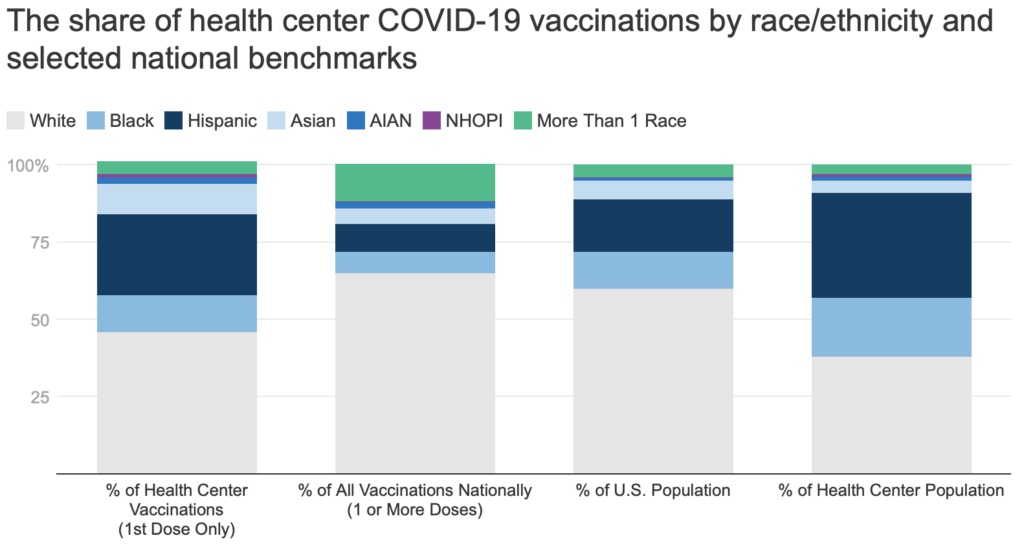
In the coming weeks, we expect more states to open up vaccine eligibility to the general public, joining Alaska (effective March 9) and Michigan (effective April 5). We will continue to keep track of these states.
Let’s move on to our discussion of higher education.
Higher education
This week’s higher education discussion revolves around two issues: spring break and vaccines. I remain concerned that spring break (and more imminently, St. Patrick’s Day), particularly in places such as Florida, may cause outbreaks on campuses in the coming weeks, particularly because most of the university populations are not yet vaccinated. The University of California at Davis is offering $75 “staycation” grants for students staying in town for spring break in late March. Some Texas colleges, however, have kept the traditional spring break.
Next, vaccines. Some states are at the stage where some college students are eligible for vaccination. Oklahoma is one of the only states (by my survey) to prioritize college residents in the state’s vaccination plan. Students at the University of Oklahoma were eligible to be vaccinated on campus yesterday. Other states may prioritize “frontline” student workers (such as residential life staff). In many states, individuals (and by extension, students) with underlying conditions are currently eligible for vaccines. Colleges should provide guidance to these students on how to sign up for a vaccine in the local community, if the university is not currently functioning as a mass vaccination site. Eligible in other states, some Brown University students traveled home to receive a vaccine. Some larger universities have already started operating as vaccination sites — roughly 26% of the University of Michigan community has been fully vaccinated as of March 5. In the coming weeks, I envision more colleges partnering with state governments to vaccinate their communities on campus. It will be beneficial to vaccinate students before they leave for the summer to avoid further spread to their families. In addition, vaccine hesitancy may be possible among younger individuals, including college students. Some schools, such as Macalester College, have added vaccination statistics to their dashboards. And no, regardless of what “many people say,” colleges (in all of the cases I am aware of) have not “purchased” vaccines or have secret stashes — all vaccines are distributed from states, tribes, cities and territories.
Here is a roundup of this week’s higher ed news:
- Many colleges have started to announce a near return to normal for fall plans in advance of the application deadline on May 1 for incoming students.
- Williams College removed 127 students from campus in response to a dorm party on February 26, the latest in the fallout from this event.
- Data from Davidson College’s College Crisis Initiative found that institutions with in-person modes of instruction this past fall had higher medians of total student infections than those with hybrid or online learning.
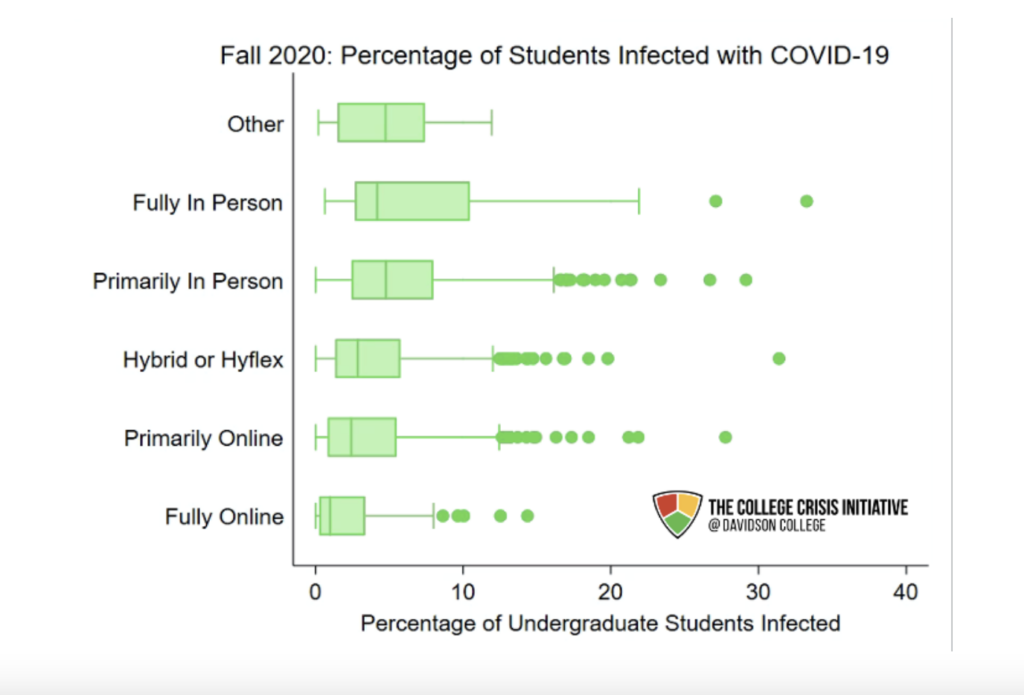
- College enrollment fell 4.5% this spring term compared to a year ago, according to data released Thursday by the National Student Clearinghouse Research Center.
- Graduating seniors at the University of Tampa are fundraising for and planning their own in-person graduation ceremony after the university decided it will offer a virtual commencement this spring due to the coronavirus pandemic.
- A paper from Baylor University researchers highlighted the “Swiss cheese” model as a successful one for college openings. Incentives were offered to participate in surveillance testing last fall and there was a governmental partnership to provide surge testing during outbreaks.
- We are actively monitoring an outbreak at Duke University, which was likely fueled by Greek life events and has now resulted in a shelter-in-place order. Duke’s men’s basketball team also withdrew from tournament play due to positive tests.
- A year into the pandemic, many international students remain stranded in both their home counties and where they go to school, affected by travel restrictions.
- A preprint from researchers at the University of Colorado at Boulder found low levels of Covid-19 transmission between roommates, which only occurred approximately 20% of the time. Notably, individuals who likely transmitted to their roommates had an average viral load ~6.5 times higher than individuals who did not. This analysis argues that inter-roommate transmission occurs in a minority of cases in university residence halls and provides strong correlative evidence that viral load can be proportional to the probability of transmission.
- Individuals vaccinated at Georgetown University receive a packet with post-vaccination instructions titled, “Hoya Vaxa,” a play on the college’s cheer of “Hoya Saxa.”
The Good Stuff
Let’s roll the clips of the good stuff. In my usual tradition, I feature my favorite stories from the week. Here are my Top 10.
- After Yo-Yo Ma received his second dose of a Covid-19 vaccine at Berkshire Community College Saturday, he transformed his 15-minute observation period into a concert for the newly inoculated.
- Reporters at BuzzFeed News wrote an eloquent and extensive oral history of March 11, 2020 — the day most Americans realized the pandemic would cause widespread disruption to their lives.
- CNN’s Brianna Keilar talked with Evelyn Shaw, who got a “hug prescription” from her doctor to embrace her granddaughter.
- The Washington Post published a detailed timeline of a year with Covid-19.
- Emory University epidemiologist Dr. Jodie Guest is the Covid-19 testing czar at the Iditarod, the largest sled dog racing event in the world.
- Actor Vick Krishna made an elaborate and clear explanation of how messenger RNA works in the body, well deserving of an Oscar.
- After completing its final data collection shift, the COVID Tracking Project published a guide on where to find federal Covid-19 data. Thank you to the hundreds of volunteers for their service over the past year.
- Some people have been dressing up for their vaccine appointment to get that perfect vaccine selfie.
- People are signing up to hug cows at sanctuaries across the country, many desperate for affection as the nation approached a full year of social distancing during the pandemic.
- The number of applications for Brown University’s master of public health program is more than double that of last year, with the largest increases coming from people of color.
Conclusion
A year after the pandemic began, this week was the first time many Americans could see a possible way out of it. With every American adult due to be eligible for a vaccine by May 1, many people can envision the summer as a time to begin traveling and having small gatherings. CNN and other companies have already announced plans to start bringing employees back in August and September. However, we must not lose sight of the present as variants can derail progress in some states and regions, which would turn into a national crisis. It is vital we continue social distancing and mask wearing practices until more Americans are vaccinated. Herd immunity is not binary; rather, it is a dimmer switch where more restrictions will be eased as the effects of vaccines will be reflected in the data. The CDC is expected to update its guidance for vaccinated people as the weeks continue.
I’d like to thank all the student journalists with whom I have the pleasure of working. In the next weeks and months ahead, they will become vital in chronicling their colleges’ paths forward for the spring and beyond. Support their work by reading it.
My best to all for good health.
Like what you see? Don’t like what you see? Want to see more of something? Want to see less of something? Let me know in the comments. And don’t forget to subscribe to the weekly newsletter!
For more instant updates, follow me on Twitter @bhrenton.

